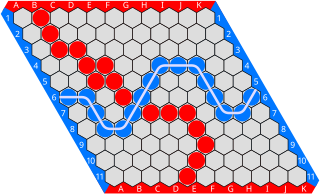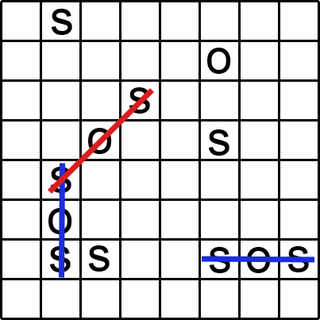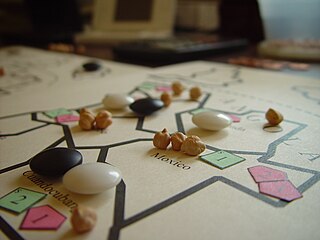Related Research Articles

Blackjack is a casino banking game. It is the most widely played casino banking game in the world. It uses decks of 52 cards and descends from a global family of casino banking games known as "twenty-one". This family of card games also includes the European games vingt-et-un and pontoon, and the Russian game Ochko. Blackjack players do not compete against each other. The game is a comparing card game where each player competes against the dealer.
Game theory is the study of mathematical models of strategic interactions among rational agents. It has applications in many fields of social science, used extensively in economics as well as in logic, systems science and computer science. Traditional game theory addressed two-person zero-sum games, in which a participant's gains or losses are exactly balanced by the losses and gains of the other participant. In the 21st century, game theory applies to a wider range of behavioral relations, and it is now an umbrella term for the science of logical decision making in humans, animals, as well as computers.

Tic-tac-toe, noughts and crosses, or Xs and Os is a paper-and-pencil game for two players who take turns marking the spaces in a three-by-three grid with X or O. The player who succeeds in placing three of their marks in a horizontal, vertical, or diagonal row is the winner. It is a solved game, with a forced draw assuming best play from both players.
Zero-sum game is a mathematical representation in game theory and economic theory of a situation that involves two sides, where the result is an advantage for one side and an equivalent loss for the other. In other words, player one's gain is equivalent to player two's loss, with the result that the net improvement in benefit of the game is zero.

Hex is a two player abstract strategy board game in which players attempt to connect opposite sides of a rhombus-shaped board made of hexagonal cells. Hex was invented by mathematician and poet Piet Hein in 1942 and later rediscovered and popularized by John Nash.
A solved game is a game whose outcome can be correctly predicted from any position, assuming that both players play perfectly. This concept is usually applied to abstract strategy games, and especially to games with full information and no element of chance; solving such a game may use combinatorial game theory and/or computer assistance.

Combinatorial game theory is a branch of mathematics and theoretical computer science that typically studies sequential games with perfect information. Study has been largely confined to two-player games that have a position that the players take turns changing in defined ways or moves to achieve a defined winning condition. Combinatorial game theory has not traditionally studied games of chance or those that use imperfect or incomplete information, favoring games that offer perfect information in which the state of the game and the set of available moves is always known by both players. However, as mathematical techniques advance, the types of game that can be mathematically analyzed expands, thus the boundaries of the field are ever changing. Scholars will generally define what they mean by a "game" at the beginning of a paper, and these definitions often vary as they are specific to the game being analyzed and are not meant to represent the entire scope of the field.

3D tic-tac-toe, also known by the trade name Qubic, is an abstract strategy board game, generally for two players. It is similar in concept to traditional tic-tac-toe but is played in a cubical array of cells, usually 4×4×4. Players take turns placing their markers in blank cells in the array. The first player to achieve four of their own markers in a row wins. The winning row can be horizontal, vertical, or diagonal on a single board as in regular tic-tac-toe, or vertically in a column, or a diagonal line through four boards.
In combinatorial game theory, the strategy-stealing argument is a general argument that shows, for many two-player games, that the second player cannot have a guaranteed winning strategy. The strategy-stealing argument applies to any symmetric game in which an extra move can never be a disadvantage. A key property of a strategy-stealing argument is that it proves that the first player can win the game without actually constructing such a strategy. So, although it might prove the existence of a winning strategy, the proof gives no information about what that strategy is.
Evolutionary game theory (EGT) is the application of game theory to evolving populations in biology. It defines a framework of contests, strategies, and analytics into which Darwinian competition can be modelled. It originated in 1973 with John Maynard Smith and George R. Price's formalisation of contests, analysed as strategies, and the mathematical criteria that can be used to predict the results of competing strategies.
Determinacy is a subfield of set theory, a branch of mathematics, that examines the conditions under which one or the other player of a game has a winning strategy, and the consequences of the existence of such strategies. Alternatively and similarly, "determinacy" is the property of a game whereby such a strategy exists. Determinacy was introduced by Gale and Stewart in 1950, under the name "determinateness".

SOS is paper and pencil game for two or more players. It is similar to tic-tac-toe and dots and boxes, but has greater complexity.
Parrondo's paradox, a paradox in game theory, has been described as: A combination of losing strategies becomes a winning strategy. It is named after its creator, Juan Parrondo, who discovered the paradox in 1996. A more explanatory description is:

Poker dice are dice which, instead of having number pips, have representations of playing cards upon them. Poker dice have six sides, one each of an Ace, King, Queen, Jack, 10, and 9, and are used to form a poker hand.

Melvin Dresher was a Polish-born American mathematician, notable for developing, with Merrill Flood, the game theoretical model of cooperation and conflict known as the Prisoner's dilemma while at RAND in 1950.
A K Peters, Ltd. was a publisher of scientific and technical books, specializing in mathematics and in computer graphics, robotics, and other fields of computer science. They published the journals Experimental Mathematics and the Journal of Graphics Tools, as well as mathematics books geared to children.
A connection game is a type of abstract strategy game in which players attempt to complete a specific type of connection with their pieces. This could involve forming a path between two or more endpoints, completing a closed loop, or connecting all of one's pieces so they are adjacent to each other. Connection games typically have simple rules, but complex strategies. They have minimal components and may be played as board games, computer games, or even paper-and-pencil games.
In game theory, Zermelo's theorem is a theorem about finite two-person games of perfect information in which the players move alternately and in which chance does not affect the decision making process. It says that if the game cannot end in a draw, then one of the two players must have a winning strategy. An alternate statement is that for a game meeting all of these conditions except the condition that a draw is now possible, then either the first-player can force a win, or the second-player can force a win, or both players can at least force a draw. The theorem is named after Ernst Zermelo, a German mathematician and logician, who proved the theorem for the example game of chess in 1913.

Game design is the process of creating and shaping the mechanics, systems, and rules of a game. Games can be created for entertainment, education, exercise, or experimental purposes. Increasingly, elements and principles of game design are also applied to other interactions, in the form of gamification. Game designer and developer Robert Zubek defines game design by breaking it down into its elements, which he says are the following:
Kaplansky's game or Kaplansky's n-in-a-line is an abstract board game in which two players take turns in placing a stone of their color on an infinite lattice board, the winner being the player who first gets k stones of their own color on a line which does not have any stones of the opposite color on it. It is named after Irving Kaplansky.
References
- ↑ Steinhaus, H. (1999). Mathematical Snapshots (3rd ed.). New York: Dover. p. 16.
- ↑ Weisstein, Eric W. (2002). CRC Concise Encyclopedia of Mathematics (2nd ed.). CRC Press. p. 1129.
- ↑ Wang, Hao (2014-09-22). Popular Lectures on Mathematical Logic. Courier Corporation. ISBN 9780486171043.
- ↑ Ashlock, Daniel (2006-04-04). Evolutionary Computation for Modeling and Optimization. Springer Science & Business Media. ISBN 9780387319094.
